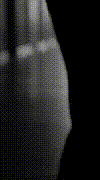
Amputation Knife (1700s)
Knives used for amputations during the 18th century were typically curved, because surgeons tended to make a circular cut through the skin and muscle before the bone was cut with a saw. By the 1800s, straight knives became more popular because they made it easier to leave a flap of skin that could be used to cover the exposed stump.

Amputation Saw (1600s)
While some surgeons chose to flaunt their wealth with elaborately decorated saws like this, the crevices in the intricate engravings proved to be a breeding ground for germs.

Arrow Remover (1500s)
Not much is known about this tool, but it is hypothesized that it was inserted into the wound in a contracted position, with the central shaft used to grasp the arrow. The blades, which appear to have their sharp edges facing outward, were then expanded using the scissor-like handles, thus expanding the flesh around the arrow to prevent the arrowhead from ripping through the meat as it was pulled out.

Artificial Leech (1800s)
Bloodletting with leeches was such a popular treatment for a range of medical conditions that an artificial leech was invented in 1840 and was used frequently in eye and ear surgery. The rotating blades would cut a wound in the patient's skin, while the cylinder would be used to produce a vacuum that sucked up the blood.

Bullet Extractor (1500s)
Elongated bullet extractors could reach bullets embedded deeply in the patient's body. Extractors like this one had a screw tip that could be inserted in the wound and lengthened to pierce the bullet so that it could be pulled out.

Cervical Dilator (1800s)
This instrument was used to dilate a woman's cervix during labor, with the amount of dilation measured on the scale by the handle. Such dilators fell out of favor because they often caused the cervix to tear.

Circumcision Knife (1770s)
Ritual circumcision is performed around the world in varying extents and for varying reasons, but few instruments used in the process are as intimidating as this European knife from the 18th century.

Ecraseur (1870s)
This ecraseur was used to sever hemorrhoids and uterine or ovarian tumors. The chain was looped over the mass and tightened using the ratchet, stopping the circulation of blood to the area.

Hemorrhoid Forceps (1800s)
These forceps were used to grasp a hemorrhoid between the blades and apply pressure to stop the blood supply, causing the hemorrhoid to drop off.

Hernia Tool (1850s)
This unique tool was used after the restoration of a hernia. It was inserted into the body near the affected area and left there for a week to produce scar tissue that would help seal off the hernia.





